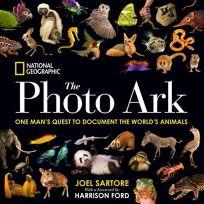Here's a fact for you: half of all Earth's species could be extinct by the year 2100. Horrifying? Most certainly. Surprising? Sadly, less so, especially to Joel Sartore, author, photographer, teacher and 25-year contributor to National Geographic magazine. In his new book, National Geographic The Photo Ark: One Man's Quest to Document the World's Animals (National Geographic, $35), Sartore sets about accomplishing his goals not only to photograph every animal in captivity across the globe, but also--and some would say more importantly--to inspire individuals to action.
 Operating on the premise that to see these animals is to recognize the need to save them, Sartore's aim is to eventually document all 12,000 captive species. Six thousand of them appear here, ranging from the beloved and well-known to the rare and unusual--even some who are the last of their kind. The Bengal slow loris shares page space with the tiger-striped tree frog. The giant deep sea roach demonstrates its startling similarity in looks to the southern three-banded armadillo. A pair of common warthogs peer proudly from a double-page spread. With more 600 photographs, you will not find a collection of more accomplished and gorgeous wildlife images. And the accompanying text, with a foreword by actor Harrison Ford and commentary supplied by author and National Geographic magazine contributor Douglas Chadwick, manages to communicate the dire situation these animals face while remaining hopeful: "The hard truth is that nature writ large will continue regardless of the specific mix of animals on the planet. It doesn't need humans to prevail. But when we start looking at species one by one... we learn where we can make a difference."
Operating on the premise that to see these animals is to recognize the need to save them, Sartore's aim is to eventually document all 12,000 captive species. Six thousand of them appear here, ranging from the beloved and well-known to the rare and unusual--even some who are the last of their kind. The Bengal slow loris shares page space with the tiger-striped tree frog. The giant deep sea roach demonstrates its startling similarity in looks to the southern three-banded armadillo. A pair of common warthogs peer proudly from a double-page spread. With more 600 photographs, you will not find a collection of more accomplished and gorgeous wildlife images. And the accompanying text, with a foreword by actor Harrison Ford and commentary supplied by author and National Geographic magazine contributor Douglas Chadwick, manages to communicate the dire situation these animals face while remaining hopeful: "The hard truth is that nature writ large will continue regardless of the specific mix of animals on the planet. It doesn't need humans to prevail. But when we start looking at species one by one... we learn where we can make a difference."
Tomorrow is Earth Day. And Sartore wants you to know the animals of the planet are calling. What will your answer be? --Stefanie Hargeaves, editor, Shelf Awareness for Readers

